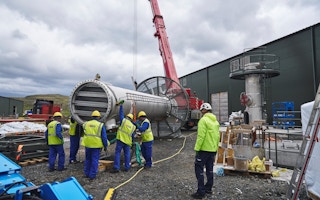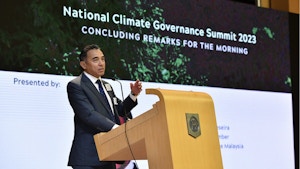In a major review of climate science last year, United Nations scientists concluded that halting carbon emissions from fossil fuels was no longer enough to keep the world to safe levels of global warming. Pulling carbon out of the air is now “unavoidable”, they said, to reach net-zero greenhouse emissions in the decades ahead.
To continue reading, subscribe to Eco‑Business.
There's something for everyone. We offer a range of subscription plans.
- Access our stories and receive our Insights Weekly newsletter with the free EB Member plan.
- Unlock unlimited access to our content and archive with EB Circle.
- Publish your content with EB Premium.
However, the credibility of carbon removal ventures – ranging from nature-based methods to huge engineering projects – along with how they should be regulated, remains hotly debated.
Diplomats worldwide have been asked to produce detailed guidance on such initiatives at COP28, as part of work on a new global carbon market. Industry players hope a United Nations-sanctioned rulebook can help boost credibility and increase revenue for nascent projects, but critics say draft recommendations thus far are insufficient to contain the risks that carbon removal projects pose to nature and societies.
Policymakers are already working behind schedule at the global climate summit, with consensus on new rules due at last year’s COP. It remains to be seen if an agreement can be reached this year, and if safeguards will be strong enough – even as the carbon removals industry continues to grow.
What counts?
There are numerous carbon dioxide removal methods currently being pursued. The simplest to grasp is afforestation, or tree-planting – since trees absorb carbon dioxide. Other nature-related solutions include better farming methods that put more carbon into soil, and the production of biochar – a carbon-rich residue formed when plant matter is heated without oxygen.
Then there are initiatives generally regarded as “engineered” solutions, though definitions are fluid. Familiar categories include the direct air capture of carbon dioxide – an effort receiving major backing by big-tech firms such as Google and Microsoft – as well as attempts at speeding up natural chemical reactions that trap carbon in oceans and the ground.
Afforestation and biochar initiatives are among the most mature, with projects already underway worldwide. Small-scale direct air capture plants have started operating, though growth is hampered by its high costs, averaging US$675 per tonne of carbon dioxide emissions according to data tracker CDR.fyi.
Other methods are still at the theoretical or experimental stages, but interest is fast growing, especially in the marine sector. The United States have poured millions of research dollars into ocean carbon dioxide removal, while countries like Norway and Singapore are hosting pilot projects. Over 200 scientists called for more research in the sector in September.
Many of the carbon removal initiatives are looking to achieve business continuity via the carbon market, where emissions trapped are converted to sellable offsets.
The market has been growing from a low base. Orders for carbon removal credits climbed from about 740 thousand at the end of 2022 to almost 5 million last month – though much of the trade volume represents advance contracts. CDR.fyi data shows that under 3 per cent of the demand has been fulfilled, in a market with about 150 sellers and 230 buyers.
New market, contested rules
At COP28, rulemaking around carbon removals are taking place under an upcoming “Article 6.4” carbon market, where projects would be listed under a UN registry and offsetting purchases from countries solicited.
The market would host a broad range of carbon projects, but policymakers have asked a 12-member supervisory body to specifically scrutinise carbon removal due to the risks it harbours.
Expectations are high for the UN-led initiative. “It will in my view form the benchmark for all other international carbon market approaches which have to follow the approaches of Article 6.4, unless Article 6.4 gets completely messed up,” said Dr Axel Michaelowa, senior founding partner at Germany-based consultancy Perspectives Climate Group.
Much attention has been on verifying that carbon emissions claimed to have been removed actually stays out of the atmosphere for good. Carbon stored in trees and soil can be released from forest fires, while those in underground rock formations can seep.
There are concerns around social and environmental harms stemming from large-scale novel ideas too. For instance, stimulating phytoplankton growth in oceans to increase carbon dioxide absorption could send marine food webs off-kilter and affect fisheries – in fact such methods have been under a moratorium. Some carbon capture technologies also require huge water and energy input.
The Article 6.4 supervisory body released a draft for climate negotiators to consider on the eve of COP28, which detailed rules such as the interval of monitoring reports (two, or five, depending on the risk of “reversals”, or greenhouse gas leakages). The market watchdog wants to be alerted within 30 days to any incidents which could cause reversals. Should such events happen, offsets could be struck off from a buffer pool, or from other projects.
Not everyone is satisfied. Belgium-based Carbon Market Watch urged countries not to accept the recommendations because too many important details remain to be decided.
The nonprofit wants the supervisory body to clarify how permanent carbon sinks need to be, the duration of post-crediting monitoring (various groups have suggested decades to hundreds of years) and for the watchdog to exclude projects offering transient carbon storage – mostly in nature-based projects. Detailed risk assessment tools and clearer definitions are also needed, it said.
“We feel the draft is more likely to remove ambition from climate action than carbon dioxide from the atmosphere,” the group said in a statement.
In the lead-up to COP28, advocacy group Friends of the Earth Nigeria also asked African governments to reject geoengineering and carbon dioxide removal to help communities avoid the risks to nature and communities.
Running late
The UN has had to balance strong opinions from both proponents and critics of carbon dioxide removal for years.
The Article 6.4 supervisory body’s latest work on regulations started after COP26 in 2021, and was supposed to be presented at COP27 in Egypt last year. But a five-page document it presented then was roundly criticised for being too light on details (the current draft has 13 pages), and global policymakers sent the paper back for revisions.
Then, a mid-year “information note” on carbon removals, meant as a landscape overview from the UN body’s perspective, drew over 400 public comments from industry players, scientists and advocacy groups.
Among those responding to the note, a coalition of 39 players in the direct air capture industry took issue that their solution was said to be unproven, and pose unknown environmental and social risks.
A point on “engineering-based removal activities” not adding to sustainable development was also picked up with “significant concern” in a letter by a group of over 100 carbon removal market participants organised by industry association Carbon Business Council, which added that the lines shouldn’t be drawn so clearly around various project types so long they meet eligibility criteria.
On the other hand, over 125 civil society organisations reiterated their stance against carbon removals, and the wider carbon market, as a distraction from getting rid of fossil fuels and making polluters pay.
Closer to COP28, the supervisory body’s issuance of the latest guidance document that policymakers are now working off had necessitated two additional unplanned meetings in November.
Some are now calling for faster progress on key principles, with the details settled by later as the industry progresses.
“The criticism [of the removals guidance] revolves around the need to have rules developed and defined in detail. My response is that you cannot do this because you would then have a thousand-page guideline,” Perspectives Climate Group’s Michaelowa said, adding that this could completely stall progress.
Business expectations
Industry players are hoping for carbon removals guidance to be finalised at COP28, to facilitate projects eventually making it into the Article 6.4 market for state buyers’ perusal.
Ben Rubin, executive director of the Carbon Business Council, noted that countries are increasingly getting into the carbon removal space, with the United States recently announcing a US$35 million procurement programme for such credits.
“I think that announcement is a floor, not a ceiling,” Rubin said, adding that he expects to see additional countries working together on removals at COP28. Wealthy countries acting as buyers could be crucial for the carbon removals industry, as many projects tend to have much higher asking prices compared to the more prevalent forest management and clean energy projects.
“The more that we have frameworks like Article 6.4 bring specificity and confidence to the market, the more we are going to see a further scaling up with carbon removal,” Rubin added. He also said it was a positive development that work around removals regulations at COP28 seems to be more technology-neutral than before.
Adrien Humbert, co-founder and CEO of biochar start-up Circonomy, which has projects in India, thinks guidance from a global Article 6.4 system will also set the tone and restore credibility in the voluntary corporate market, where the proliferation of different standards have made the space “messy”.
“The trust is not here anymore in the voluntary carbon market, and we need to bring back that trust to develop more projects,” he said. In the past two years, media exposes of major project shortfalls have made offset buyers wary and caused a market slump, along with macroeconomic headwinds.
But it is still too soon for Adrien to say how big a market opportunity would be offered by Article 6.4, given the slow pace of progress.
“The Paris Agreement was eight years ago. We thought maybe at Glasgow [COP26, in 2021], we would have something, but we had nothing. Today, we are at COP28…with some recommendations,” he said.
The removals industry could still grow without Article 6.4. Major carbon project certifiers have started to look at removal methodologies to support the voluntary market, and one of them, Finland-based Puro Earth, focuses exclusively on this space.
Some experts also see more opportunities under another UN “Article 6.2” mechanism, involving bilateral country trade and less oversight from the global body – but this would again carry reputational risk.
“If countries pursue projects on an Article 6.2 basis, they also need to think about their reputation. If countries go ahead with broad or flimsy approaches, I would expect them to be called to order,” said Michaelowa.
Circonomy’s Humbert thinks COP28 can do the industry a favour through another line of negotiations.
“One agreement I want to see from COP28 is the phase-out of all fossil fuels…then we can decide how we can support carbon removal to grow,” he said, adding that this would address criticism of carbon removals being a distraction to decarbonisation.














